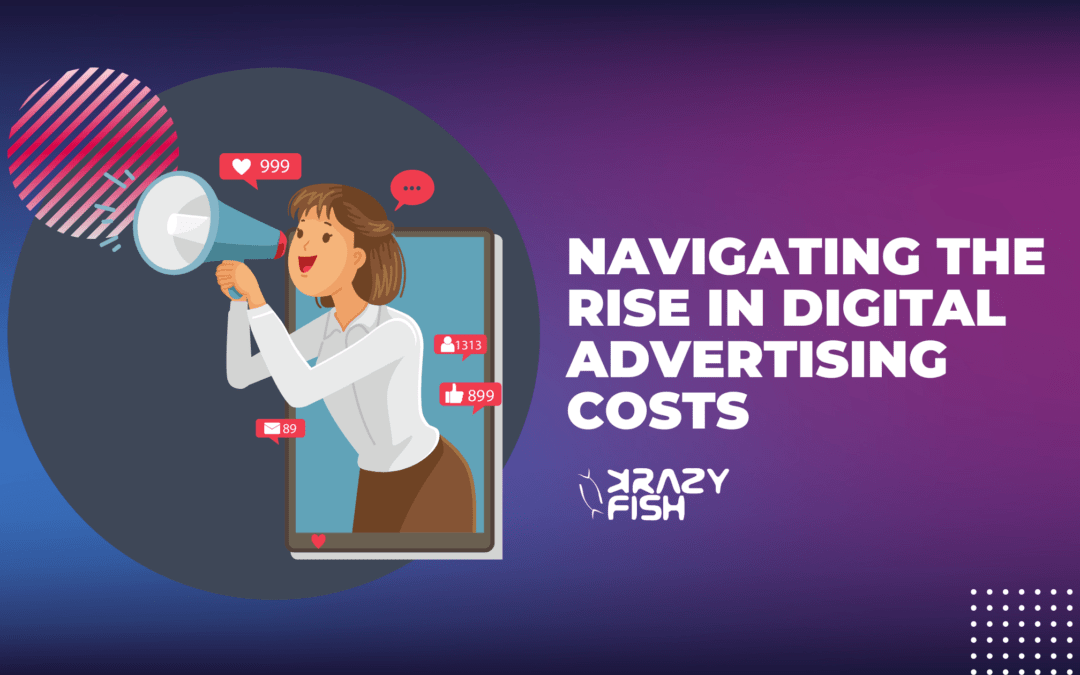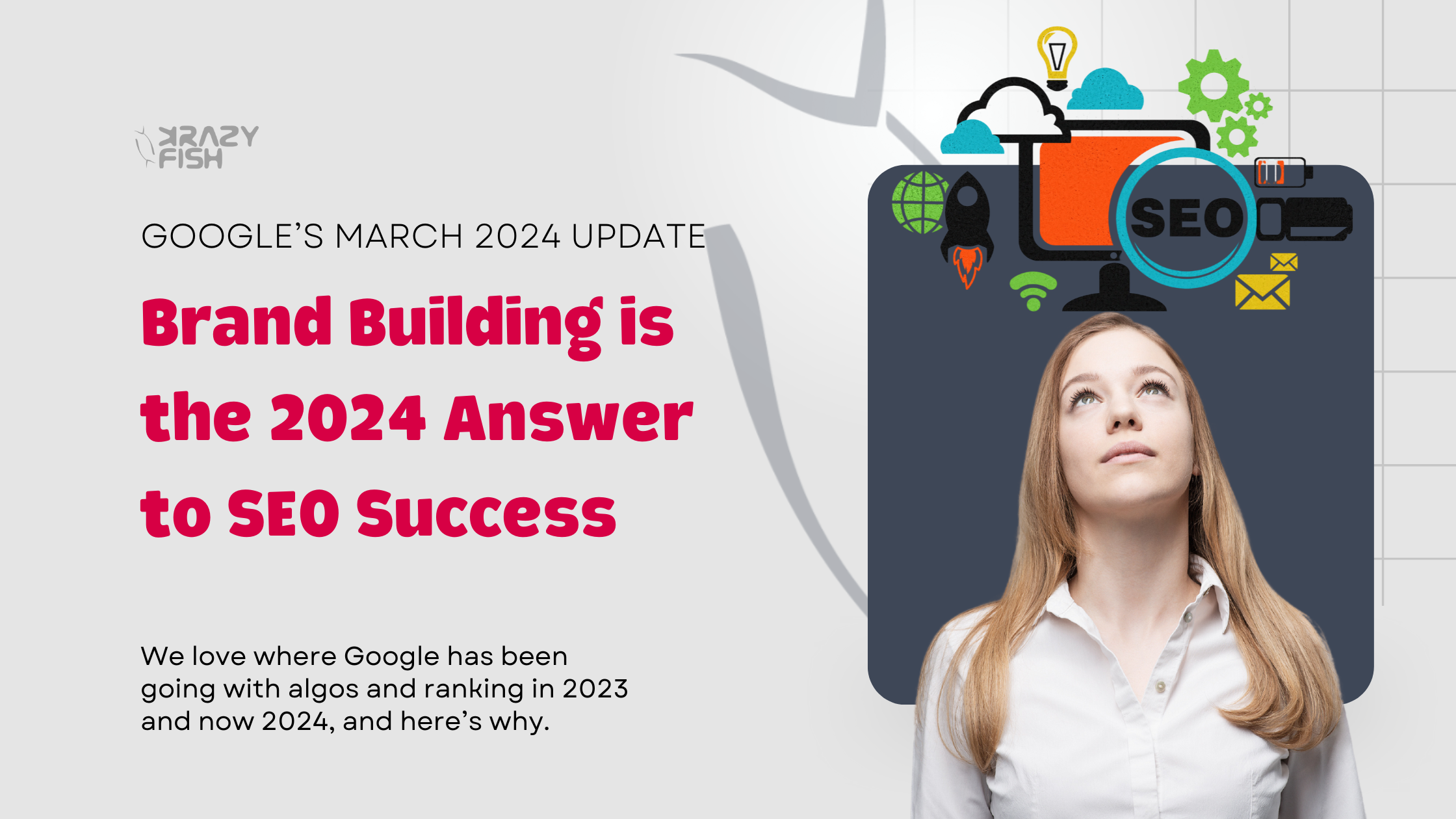The year 2023 in the digital space has already been quite a ride. Let’s talk about the financial rollercoaster that is digital advertising today, where advertising costs have more than doubled on some popular platforms. Fasten your seat belts because the ascension to stratospheric costs isn’t going to slow down anytime soon.
The digital ad space has always been a bit like a chaotic marketplace, a bustling souk where buyers and sellers haggle over ad slots. But recently, it seems that marketplace has caught a fever. Digital advertising costs are rising faster than a soufflé in a restaurant’s oven. Is it inflation? Global warming? AI? No, just the good old law of supply and demand playing tricks on the market.
If you’re a small business owner, you’re probably feeling a bit like David going up against Goliath. Your slingshot is full of creativity and entrepreneurial spirit, but Goliath’s armor is padded with big-budget ad spends. Is it fair? As fair as the fight between a Chihuahua and a Rottweiler over the last piece of steak.
While you can’t outspend the big guns, you can certainly outsmart them. So, put on your thinking caps, because we’re about to explore a few savvy strategies to navigate the rise in digital advertising costs. Spoiler alert: it involves a bit more than just hoping your competitors get abducted by aliens (although that would certainly help).
Get to the Point
Understanding the Surge
To understand this massive surge, let’s investigate the culprit behind the soaring costs of digital advertising for small business. Cue Law & Order intro music and let’s take a look at several suspects.
First on the stand, we have supply and demand. The digital ad space, much like your favorite bakery at lunchtime, has limited space. There are only so many ad slots available, and far too many businesses are elbowing each other to get in line. Think of it as a digital version of a Black Friday sale – chaotic, competitive, and a little bit cutthroat.
And then there’s the aftermath of the pandemic, also within supply and demand. The year the pandemic hit, 2020, digital ad spend saw near 0.0% growth. Which is still better than some industries and services did. Demand was especially lower from small, local businesses, such as restaurants, coffee shops, and small retail stores, which didn’t have much need for advertising during lockdowns and whose budgets were decimated by the time the world began opening up again and adjusting to the “new normal”. And then, suddenly, demand began rising astronomically as people tried to recover and get back to business as usual.
Then there’s the incessant demand for online attention. The pandemic pushed even the most traditional businesses online. Now everyone wants a piece of the digital pie. Everyone’s shouting into the same megaphone and, to be heard, you have to shout louder – or, in this case, pay more.
And let’s not forget about the tech titans – Google, Facebook, and TikTok – constantly changing their algorithms. One day you’re in, the next day, your ads are lost in the digital abyss, and you’re paying more to rescue them. To be fair, the algorithms most networks had in place worked well for a while. By 2019, they were already outdated when met with new rising content types and changed user behavior. Needless to say, the pandemic may not have directly caused those changes, but it did supercharge their adoption and usage.
By mid-2022, digital ad costs looked like this:
Meta’s (previously known as Facebook) CPM (cost per thousand) increased 61% year over year, averaging at $17.60/CPM
TikTok’s CPM (cost per thousand) increased 185% year over year, averaging at $9.40/CPM
Google’s programmatic display CPM (cost per thousand) increased 75% year over year.
Google search ad CPC (cost-per-click) increased by 14% year over year.
Instagram’s CPM (cost per thousand) increased 23% year over year.
A year has passed since and those numbers just keep rising. Indeed, the plot of digital advertising for small business has thickened considerably, leaving us all clinging to our wallets and scratching our heads. But this story doesn’t end with a cliff hanger and us staring despairingly into the increasing void. No, we are but at the start of our journey. And, now armed with understanding, we shall chart a course through these treacherous waters.
How It Affects Small Business
Let’s look at how all of the above impacts small businesses. As if it wasn’t challenging enough running a small business, now you’re expected to cough up more cash for digital advertising. It’s like going to a fancy restaurant and realizing they’ve doubled the prices but not the portion sizes. You’re left hungry and feeling a bit cheated.
When the costs of digital advertising for small business start to skyrocket, the marketing budget starts to feel like a particularly grueling episode of Survivor. Except, instead of voting off irritating contestants, you’re desperately looking for a strategy that works whatever budget you have.
The tragedy here is that digital advertising is no longer a luxury or a fancy add-on. It’s a necessity, the engine that drives visibility, customer acquisition, and growth. So when costs go up, it’s not as simple as just deciding to give it a miss. Unless, of course, you fancy the idea of running a modern business that’s virtually invisible online.
So, here we are. Your budgets are straining, your stress levels are climbing, and you’re probably considering investing in a solid punching bag with the face of rising ad costs. Before you take your frustration out on inanimate objects, let’s try to figure this out.
Smart Budgeting for Digital Advertising for Small Business
Well, now that we’ve established that the rise in digital advertising costs is about as pleasant as stepping on a Lego brick in the middle of the night, it’s time to arm ourselves with some smart budgeting strategies. Buckle up, my budget-conscious comrades. It’s about to get financially savvy in here.
The first rule of digital advertising for small business is to make every penny count. In the wild world of digital marketing, however, that’s easier said than done. By focusing on strategies that lower costs and bring you the most return, there is still plenty of room in the digital ad space for small businesses.
Absolutely, here’s the text rewritten in a more professional and expert tone:
- Audience Targeting Precision
In the realm of digital advertising for small businesses, precision is key. You are competing against hundreds of brands in an advertising bidding war. It is essential to accurately specify your audience to reduce competition and increase the likelihood of your specific target audience engaging with your advertised content.
- Embracing Video Content
Throw yourself into video content as a highly successful, cost-efficient advertising method. The cost per click (CPC) for video content is generally lower than that of carousels or single-image ads, making it a more budget-friendly choice for small businesses.
- Segmentation for Effective Retargeting
Proper segmentation of website visitors based on their level of engagement allows for more effective retargeting. Custom retargeting algorithms help classify your website visitors into various engagement groups, leading to more personalized and impactful advertising campaigns.
- Leveraging the Facebook Tools
Use tools like Facebook’s Audience Overlap to see if your target audiences overlap significantly. This enables you to select the most relevant segments for your marketing goals and avoid bidding against yourself in ad auctions. Installing a Facebook Pixel on your website provides a wealth of data about your customers. This tool enables you to track conversions, collect data, and target people who are more likely to purchase a product. It’s a valuable addition to your digital advertising arsenal.
- Testing and Optimizing Creative Materials
Performing regular testing of your creatives ensures that your advertising material is optimized for the best results. Slight changes in images, text, or call-to-action phrases can significantly affect your ad performance over time. Continual testing and refinement are key to ensuring your budget is well spent.
- Cap Bids Strategically
Bid caps are a useful tool for managing your advertising spend based on the lifetime value of individual leads or sales. Facebook offers three distinct bidding strategies – expenditure-based, goal-based, and documentation. Choosing the right strategy can help optimize your ad spend and achieve your advertising goals effectively.
- Website or Landing Page Optimization
A well-optimized landing page is one of the easiest things you can do to reduce your cost per conversion. Successful landing pages often feature a simple, user-friendly design, use appealing and contrasting colors, and place key elements and contact information above the fold. Neglecting optimization can lead to poor user experience and increased bounce rates due to slow loading times or unclear messaging.
- Understanding Keywords and Search Intent
Successful PPC campaigns hinge on understanding the user’s search intent behind specific keywords. This research not only attracts serious buyers but also augments your SEO rankings. Certain keywords are likely to yield higher conversions for your business and prioritizing those significantly stretches you budget.
- Aiming for a High Google Ads Quality Score
A high Quality Score in Google Ads often equates to a lower cost-per-click and, consequently, a lower cost-per-conversion. Understanding and improving your Quality Score can significantly enhance your campaign’s profitability.
Digital advertising for small businesses demands a strategic and nuanced approach. By understanding the tools at your disposal and implementing them thoughtfully, you can optimize your strategy for maximum results.
The Power of Organic Reach
It’s time we had a heart-to-heart about the unsung hero of digital advertising for small business: organic reach. Yes, the rumors are true, despite the best efforts of some of our colleagues in trying to convince you that organic reach is a fable. You can indeed reach people without paying an arm and a leg.
Let’s not go overboard though. Organic reach isn’t some magic potion that’ll make your advertising costs disappear and it most certainly doesn’t come easy. It’s more like a supplement to your digital advertising strategy.
- On Point SEO
Search Engine Optimization is all about making your website or blog more attractive to search engines than a beach is to sunbathers on a hot day. This means using keywords effectively, ensuring your site loads faster, and producing quality content that’s more engaging than a Netflix show finale. We already mentioned optimizing your website and landing page, but your organic SEO strategy needs to go much deeper than that. For instance, if your on-site SEO is off (or even negative), then optimizing a few landing pages won’t get you far.
- Social Media
Active social media accounts also play a huge role in organic reach. Those platforms we talked about earlier? They’re not just good for paid ads. They’re also excellent for engaging with your audience, starting conversations, and building relationships that are more meaningful than a high school sweetheart. By pursuing a content marketing strategy, you’ll need fewer ads and less spend on those ads.
- Old-fashioned Word-of-mouth
Happy customers are like personal cheerleaders, spreading the word about your business without costing you a dime. Explore various IRL and online methods to increase engagement with your customers, prompting them to talk about your business, and spread that WoM through more organic social media activity.
Organic reach is a slow and steady strategy that, when done right, can help offset some of the costs of digital advertising for small businesses. Get out there and start planting the seeds. After all, good things come to those who wait.
Leveraging Micro-Influencer Partnerships
Speaking of word-of-mouth and organic reach, micro-influencers are like the indie bands of the social media world. They may not fill arenas, but their dedicated fan base hangs on their every word. And that can be a game-changer for your digital advertising strategy.
These micro-influencers are probably in your vicinity or they may already be your customers. With their small but dedicated followings, these individuals are often seen as more authentic and trustworthy than their A-list counterparts. It’s like comparing a home-cooked meal to a five-star restaurant. Sure, the latter might be flashier, but sometimes you just can’t beat the genuine, heartfelt nature of the former.
Leveraging these partnerships can be a cost-effective way to boost your brand awareness, engagement, and even conversions. It’s like getting a local celebrity endorsement without the eye-watering price tag. Before you go sliding into the DMs of every micro-influencer you stumble upon, remember that, like any good relationship, it’s all about the right match. Their audience needs to align with your target market, and their content style needs to resonate with your brand.
The Value of Remarketing
Remarketing is the digital equivalent of bumping into an old flame in a coffee shop and realizing the sparks are still there. It’s about re-engaging with potential customers who’ve already shown an interest in your business but, for some strange reason, didn’t quite make it to the checkout.
Perhaps they got distracted by a phone call, their kid broke a lamp or their cat walked across the keyboard mid-purchase. Who knows? The point is, they were interested, and with the magic of remarketing, you have a second chance to reel them back in. The beauty of it is that these aren’t cold leads. These are warm leads who are already halfway up the ladder of your sales funnel. With a gentle nudge (aka a strategically placed ad), they could tip right over the edge and into the glorious land of conversions.
And there’s a ‘but’ here too. Remarketing does require a bit of strategic thinking and some clever execution. You can’t just throw ads willy-nilly and hope they stick. But with a little bit of effort, you can craft a remarketing strategy that delivers more bang for your buck than a Black Friday sale.
What to Do As a Small Businesses
We’ve journeyed through the arid plains of increasing costs, found oases in the deserts of cost-efficient platforms, and discovered hidden treasure troves in the form of organic reach, micro-influencer partnerships, and the tantalizing enigma that is remarketing. Digital advertising for small business doesn’t have to be a David and Goliath battle, where you’re perpetually stuck playing the role of the underdog. With the right strategies, you can not only play in the big leagues, you can actually make a splash.
Now, go forth. Harness the power of organic reach, partner with those feisty micro-influencers, and reel in those elusive almost-customers with some cunning remarketing. And remember, even when the seas get choppy, keep your ship steady and your compass true. For more actionable advice and to delve deeper into the world of digital marketing, don’t forget to follow our brand new YouTube channel, where we answer real questions from real people just like you. It’s digital marketing demystified, right at your fingertips.
And if you’re looking for a tailored approach, we’re here to help. At Krazy Fish Media, we understand that each small business is unique, with its own goals, challenges, and resources. Get in touch for digital advertising plans that are tailored to you, your business, and your goals.
May the ad bids be ever in your favor!




